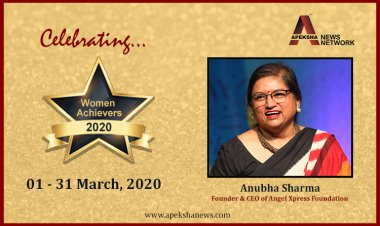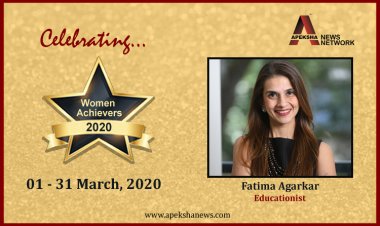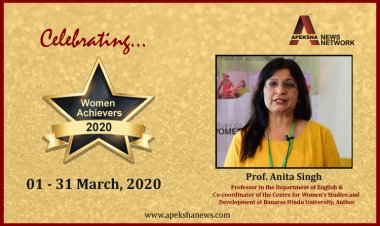“The ultimate challenge for the classical dancers today is to find fresh new ways of expression, and to communicate without compromising the integral spirit of the dance form and tradition.” - Alarmel Valli, Indian Classical Dancer & Choreographer

India is known for its art and culture, which is only made possible by the artists who practice that respective art. Bharatanatyam is part of our culture and whenever name of this art form is mentioned, the name that follows is of Padma Bhushan and Padma Shri Alarmel Valli, the most popular performing artiste of Bharatanatyam. As they say that age is just the number, at 63 Valli steals the show by displaying a unique balance between technique and lyricism as well as her ability to turn a traditional grammar into deeply internalized, personal dance poetry. She has been dancing since the age of 6 and was only out of action for 18 months owing to breast cancer.
Producer Michael Macintyre has made a film on the ace dancer Alarmel Valli for the Omnibus series that was telecast on BBC One. Valli has been featured in various dance documentaries by noted Indian producers such as the one made by late G. Aravindan and Prakash Jha, by the BBC in The Spirit of Asia Series, the Netherlands Broadcasting Company, Arte (France) and Japanese National Television, to name a few. The Films Division of India has commissioned a film on Valli for the National Archives of India, titled 'Pravahi'. Director Sankalp Meshram had made a documentary about Alarmel Valli titled ‘Lasya Kavya’, which won the National Film Award for Best Arts/Cultural Film in 2011.
To pass on her art and knowledge to the future generations, Valli founded ‘Dipashikha Centre for Fine Arts’, where she herself teaches dance to the aspiring artists.
In an exclusive interview with Apeksha News Network, Valli talks about her interesting journey and role of her mother in it, her relationship with dance, the issues faced by classical dancers and artists in India and much more. Check out the excerpts!
Tell us something about your Journey as a classical dancer so far.
When I was just two days old, I remember our family astrologer predicted that I would become a famous performing artist. As I was not exactly a pretty baby, my mother was somewhat skeptical about this prediction. However, when I started bawling lustily, she jokingly commented that perhaps I would be a singer. Much later, when I had achieved wide recognition as a dancer, she showed me the tattered and yellowing notebook where the astrologers had written down their uncannily accurate predictions.
Noticing my early predilection for dance, at the age of six, my mother took me to train under the great gurus, Pandanallur Chokkalingam Pillai and his son, Subbaraya Pillai, repositories of the lofty Pandanallur dance tradition. I was a painfully thin and small child and relatives would often remonstrate with my mother, saying I was too frail to dance. But my mother made me aware that there is a strength that can transcends the physical, which makes the seemingly impossible, possible. Without her courage, support and faith in me, I wouldn't be a dancer today. At 5 am every day, she would make sure I was out of bed and ready for dance class, which would go on for two and a half hours, and sometimes longer.
Needless to say, I was often late for school. To my mother, dance was a 'sacred commitment' and there could be no half-measures. It was she who gave the dreamy, careless child I was, the much-needed focus and courage to follow my dreams.
I had some hazy notion of becoming an astrophysicist. But a unique invitation to dance at the world-famous Théatre de la Ville festival in Paris, when I was just sixteen changed the trajectory of my life. The festival dates clashed with my public exam, forcing me to make a choice to lose a year of college and though I returned the next year to complete my BA in English Literature, dance became the focus of my life.
The early years of my training seem like another decade, free from the tyranny of television, Internet, social media or cell phones, when we had time to listen to silence. The lack of technology was actually an advantage, for it obliged me to focus, observe, introspect and internalise - a process that freed the imagination and stimulated creative growth. Today, with the advent of what the DVD and YouTube “gurus”, there is the danger of dancers slipping into a culture of imitation. Technology can be a boon, but one has to guard against it becoming a crutch!

You are a trained classical dancer and also learned music under T. Muktha, of the Veena Dhanammal style of music for many years. Why did you choose dance over music as your career?
When I dance, I feel I am also a poet, painter and singer - writing my personal dance poetry, painting my dancing spaces and singing with my body. So, although I am a dancer, I nevertheless also consider myself a singer - singing with my body.
In my teens, I heard the great dancer, T Balasaraswati say with reference to teaching Abhinaya, “It cannot be taught. It must flower on its own.” I wondered how that could possibly be. It was only when I studied music with Balamma's cousin, T Muktha, also a granddaughter of the legendary musician, Veenai Dhannammal, that I perceived her meaning. Learning the unmatched rendering of padams and javalis in their music style, suddenly, I found my body instinctively responding to the curves and cadences of the music. To my mind, word, melody and movement are inseparably linked; and I have long approached and interpreted dance as visual poetry and visual music.
Each dance form has its own importance and soul. Being trained in multiple dance forms, with which one do you find connect more as a person?
I have trained only in two dance forms - Bharatanatyam and Odissi. The sensuousness and lyricism of Odissi captivated me. Fortunately, Guru Kelucharan Mohapatra agreed to teach me and for around ten or twelve years, from my seventeenth year, I had the great privilege of studying Odissi under him and his senior disciple Ramani Ranjan Jena. It was a precious enrichment.
But I realised that in a lifetime, it is not possible to fathom even a fraction of the complex and profound depths of just one dance form. I found I had no time to commit to Odissi, the total dedication that an art form demands if you aspire to excelling in it. I decided therefore that I would focus on my first love, Bharatanatyam.

What barriers have you faced, as a woman, in becoming successful in your field? How did you overcome them?
Being in college in the seventies was a dynamic and happening time. But despite liberal ideas, in my generation, young people would seek cues mainly from the West, and classical Indian dance was not on their radar. In fact, in school I hid the fact that I used to perform. And in college, I actually had two distinct sets of friends - my classmates who were close friends, but had no interest at all in my persona as a dancer, and the rasikas, who were twice my age, who sought and included me in their social circle, precisely because they loved my dance.
Today with thousands of young women drawn to dance as a profession, it is difficult to imagine a time when it was not an acceptable career choice for a woman. You had to break down deep-rooted prejudices and preconceptions to opt for a career as a dancer. If not for my mother’s open-mindedness and persistent support, I may well have been packed off to Cambridge to study for a career in law.
What is the biggest struggle of a classical dancer today in India?
I would say the major obstacles for classical dancers these days, include an over-crowded dance world, rampant commercialisation, a dearth of sufficient good teachers and all the attendant negative consequences.
To be a classical dancer today is very expensive, almost prohibitively so. But dancers, unfortunately still command a much lower fee than musicians of a similar stature and for a young dancer to opt for a profession as a dancer, he or she has to have a financial cushion, or powerful influence. Thousands of young dancers vie for chances to perform, in Chennai alone. To make their voices heard, many have to resort to the Wow factor. In the last decade, I have seen sensational physicality; gimmicks and acrobatic movements predominate in Bharatanatyam. But the true magic of this form lies in its subtle, understated complexity, its profound and intense musicality, its rich lyricism and joyous spontaneity. If these delicate nuances and subtexts are lost in the pursuit of sensationalism, it would indeed be a great pity.
Most of the great masters, who could transmit the richness, poetry and musicality of this dance language, have unfortunately passed away. YouTube and Dance DVDs have become substitute gurus, given the huge demand. Also, dance has become an aggressively PR-driven profession. Even mediocre dancers who know how to manipulate social media can gain a following and adversely influence young minds, rather than talented ones who are not so PR savvy.
The ultimate challenge for the classical dancers today is to find fresh new ways of expression, and to communicate without compromising the integral spirit of the dance form and tradition. It is only when our dance becomes an authentic and deeply personal language of self-expression, when we dance with joy, passion and truth, can it have the power to communicate universally, across languages and cultures.
A classical dancer or young woman, who wants to take her talent as a career, does not always start off from a level playing field compared to a young man from the same community. She may not have access to the resources or platform she needs to begin her career and she may also have other time commitments like family, childcare, etc. Do you think the existing programs introduced by the government need enhancement? Any suggestions to the government?
I am not aware of Government schemes that specifically address support for women artists. If there are, the problems lie with the implementation of such measures. I remember the indignity my own guru and aged singer were put to, to receive their artist’s pensions on time from the government. Performing artists need to jointly address these issues.
In the coming years, I have plans to contribute through my Dipasikha Dance Foundation, towards creating support for elderly and indigent artists. I also have plans to create a corpus towards offering stipends and scholarships to young girls from economically under-privileged backgrounds. Even if they may not become successful performing dancers, they can still teach dance, which is a very lucrative profession today. So may be government can do something like this for the artists across India.
What are few qualities, if a person has, then only he/she should think of having a career as a classical dancer?
Discipline and hard work, dedication, passion and single minded-focus, devotion, humility and patience, creativity and a seeking mind, the ability to enrich oneself and grow - and importantly, a fine gift for dance. I would consider all these qualities vital to becoming a complete professional dancer.
Based on your own experience, what advice would you give to women considering pursuing a career in classical dancing?
In today’s context, a career in classical dance is a thorny and uncertain path. A dancer who is serious about a career should focus first on deeply internalising the language and grammar of dance with a good guru. Only relentless, regular practice, backed by introspection and enrichment, can lead to the deep internalisation, so vital to creative growth.
I encourage my serious students to learn music and to read good poetry and literature, as the musicality and poetry inherent in a dancer’s art, marks the difference between a complete artist and a mere performer.
I think it is important for every professional dancer, no matter how successful, to remember that the art is always greater than you.
You have been an amazing teacher and extraordinary dancer. Not all professionals can be good teachers. Comments.
For me, teaching dance is not merely about imparting a strong foundation in dance grammar and vocabulary. It is equally about infusing students with a sense of wonder in the myriad colours of dance - as a celebration of the body, mind and spirit. Most of all, teaching is about helping young people realise their full potential. I have spent hours at the feet of my Gurus, imbibing not just dance and aesthetics, but also values and principles. It sensitised me. I try and do the same for my students. And I hope I have helped them understand the fact that, current trends notwithstanding, there can be no ‘instant’ dancers, like instant idlis or cake mixes!
A dance style is like a majestic Banyan Tree; the Gurus are the mighty branches, who send down strong roots. Each grows into an individual tree - separate and unique, yet connected. I am fortunate to be a part of this great Pandanallur tree. It is important for me that I share my legacy with my students, so that they too can send down their own roots and the tree continues to grow and spread as a symbol of renewal and regeneration.
Art (any form) plays a huge role towards the growth of the country, considering culture, youth, etc. What do you feel that what kind of art India needs currently?
At a time when there is so much hatred, violence and chaos in the country, I feel art can play an important role in healing. The exact genre of art doesn’t matter as long as it is value-based and harmonising. Jawaharlal Nehru, speaking of culture once said, “It is the ability to understand other people’s point of view.”
It is vital that we sensitise our youth and make them more understanding of other religions and cultures, more tolerant - before the chasm becomes too wide to bridge. Arts that foster values can be a great help in achieving this.
I remember a performance in France many years ago with artists from around the world. One of the groups was from Pakistan. At the time, relations between India and Pakistan were at an all-time low and war seemed imminent. Yet, the warmth and admiration between us and the Pakistani musicians, our mutual admiration and goodwill were palpable. Our music and dance forged a strong bond. Pakistani and Moroccan musicians, Indian and Tajikistan dancers were all dancing, singing, gesticulating together and harmoniously communicating.
What main change would you like to see for young girls in the next generation?
I long for a safer India for girls and women, with better implementation of laws favoring women. Thanks to my parents, I had many avenues of self-expression open to me and the freedom of choice to decide what path I would follow. I pray that in the not-too-distant future, young girls, both rural and urban will have more freedom and access to better education and opportunities in life and work, unhindered by gender bias.
If you could give one piece of advice to your younger self, what would that be?
Learn more detachment and don’t over-react. Learn to prioritise, instead of trying to invest the same attention to detail to everything you do. It is neither practical nor wise!
What woman inspires you and why?
Many women have inspired me over the years. But the one who has had the most impact on my life is my mother, who was my mentor, anchor, my most discerning critic and constant companion on every step of my dance journey. A lady of vision, far ahead of her times, my mother could truly be described as a ‘Renaissance Woman’. She was a fine scholar in English and Tamil with a honed writing style, who revelled in travel and took much joy in exploring diverse cultures. She was a gourmet cook, with a great zest for life and a wonderful sense of humour.
In fact, of the two of us, she was the more adventurous spirit, braving the steep climb into the heart of the Great Pyramid in Giza, or to the top of the temple at Chichenitza in Mexico, when even young members of my orchestra jibbed at it.
As a child, when I pestered her to buy me things, she would sometimes set me on her lap and remind me that money was a fickle thing, here one minute, gone the next. “True wealth is your education and your dance, which no one can take away from you. So, focus on enriching yourself, rather than wanting to buy everything you see,” she would say.
Her philosophy of life was crystallised in those immortal lines from Shakespeare’s play, Hamlet... “This above all: to thine own self be true, And it must follow, as the night the day, Thou canst not then be false to any man.” In my mother, there was not a single false bone, or hypocrisy, which she deplored above all else.

International Women’s Day celebrates the scientific, political, economic and social achievements of women. In your experience as a successful woman, what is its significance?
Women are the very pillars on which society rests, and I believe the health of a civilisation depends on the status of its women. Irrespective of her education, whether she is urban or rural, rich or poor, every woman enriches society in her own way and the more empowered women are, the better the world will be - less violent and perhaps more enlightened. To remind us each year of women’s achievements and extraordinary contributions is vital and a fitting cause for celebration!
Apeksha News Network congratulates Alarmel Valli for her contribution and commitment towards the society with her art as well as works and wishes her all the best for her future endeavors!















































